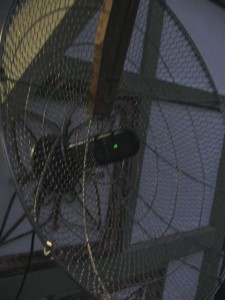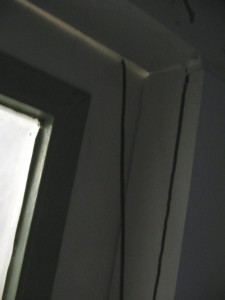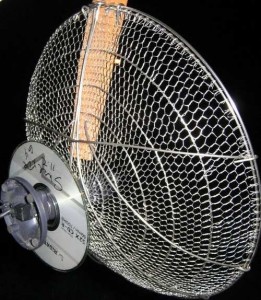Exactly three weeks ago today I caught myself before hitting the “share” button on my Google Plus stream. My intent was to complain about some thing or another. I believe it was an out loud groan about a USB wireless device not working out of the box with Linux. I think I was going to triangulate on Broadcom’s insistence on making wireless a real headache.
And yeah, it doesn’t take that much to get a Broadcom chip working in most cases. Unless you are installing Linux at a friend’s house or another place that doesn’t have a wired connection. Then you’re pretty much sunk. The popup says that the wireless will work once you connect to the package manager. Uh, what if I am not located near a wired connection? That’s kinda why I wanted to connect to the web anyway you friggin’ ijit.
Let’s say it together…you’re pretty much sunk. Still. In 2014. Sunk.
There are a lot of other things that are deserving of our collective ire. Wireless shouldn’t have been one of them for me. I chastised myself for throwing my own little private snit concerning something so trivial. If you count back the years with me, the kernel update to 2.27 saw wireless go from “wireless sucks in Linux” to “holy crap, wireless works in Linux.” Or it did for the most part anyway. It was an important mile marker for desktop Linux.
And it’s gotten incrementally better since then. Two things have switched places for me: struggling to get wireless working, has changed places with my expectation that wireless will work out of the box.
But all this ruminating about wireless brought something to mind. It was 2009 and I was living in a garage apartment shortly after my divorce. The only thing the apartment didn’t have was Internet access. It was gonna cost $800.00 to get the line run from the street to the building. My landlord said if I paid the installation fee, I could have internet.
Oh, and just what do you think happened?
Being sued for divorce…
Check.
Living in a friend’s garage apartment until I could get back on my feet…
Check.
Getting a wire run to my apartment…
Uncheck.
Undertaking the task of getting wireless access from a house 170 feet away…
Check.
So I started researching the possibilities for a decent wireless signal and an idea began to grow. I called my buddy Skip Guenter to see if he had any ideas. Indeed he had. What follows is a tongue-in-cheek report on how we made that wireless access possible. And not only possible, but with a signal strength that was amazing, given that we had to go 170 feet and through two wet walls. We hope you have as much fun reading it as we did writing it. So here it goes…
Wireless innovation is evolving…and Skip Guenter is the architect.
The call came in about 7 p.m. last Monday. It was from Skip Guenter.
“You on a secure line?”
“Yeah”, I said.”I guess so.”
“Well, I can’t take the chance it’s not secure. Stay there. Don’t leave and don’t tell anyone I’m coming.”
With that he hung up.
Within the next two hours, Skip “I-Can-Do-This” Guenter revolutionized the PC wireless world. His innovation, while shamelessly stolen, did miraculous things, and I am here to present it to you today.
Ladies and Gentlemen, I present to you the DSWD – V1 and DSWD – V2.
Original night research at Skipsjunk’s remote facilities to maintain highest security levels on development.
Note in figure one the surgical precision by which Guenter cut and splayed the metal mesh to insert the highly developed USB wireless adapter extension. You won’t find that quality of craftsmanship anywhere in today’s manufacturing environment.

Of further note is the high-tech USB signal routing cabling device (in figure two below) used in this technological marvel. Yes, I know…it’s breathtaking. Drink in the precision of its placement. It’s understandably overwhelming, I know.

Of course, the calculations used to increase signal strength took hours. Using the Linux Supercomputer at the secret night-time testing location, Guenter was able to hone the signal from a constant 47 percent to a signal that ranged from 72 to 94 percent.
But despite his brilliance and tenacity, problems persisted. The signal would fluctuate between the aforementioned percentages. For anyone else, this vast improvement would have sufficed.
But not for Skip “94percent” Guenter.
After crunching the numbers for what seemed to be hours, Guenter began to develop an answer to the problem. Sheer genius prevailed, along with brilliant engineering to steady the signal to a 5 point fluctuation…an acceptable range for Guenter. While solid signal strength did drop from the previous peak of 94 percent — the constant range of 83 to 88 percent insured a steady signal.
Given that the wireless router is 170 feet away and sitting behind two load-bearing walls with plumbing, it’s nothing short of amazing.
The new improved version (v2) provides steadier signal levels with the new specially designed and formulated “double backplane reflector.”

Not only was the engineering and focus of this project without peer, the mounting of the device was stunning.
Because of security concerns around the avant guard mounting method, we’ve had to exclude any photos that depicted the mounting mechanism.
Besides the giant black zip ties don’t show up so well at night and nobody has a lens that’ll show the nail jammed between the sheet metal roof and the 2×4 beam from which it hangs.
Once applications were filed for the appropriate patents and all components of the DSWD – V1 and V2 were deemed as proprietary, we were able to present the DSWD – V1 in the daylight.

But seriously folks…
All kidding aside, this was built for about 30 bucks and did boost the wireless signal about 44 percent. What you are seeing is a Belkin USB dongle attached to an extension coupler and run inside through a crack in my door. The “parabolic” effect is actually a dumpling skimmer used by many Chinese restaurants to dish dumplings and strain them from the cooking pot. You can purchase one at any Asian market for about 10 bucks. I’ve bought signal boosters that cost almost twice what building this did and it didn’t increase the signal but by maybe 20 percent.
My thanks to Skip “operators-are-standing-by” Guenter for his time and patience in helping me put this together. Oh, and 5 years later? That dumpling skimmer is still hanging on my wall at Reglue.
Ken Starks is the founder of the Helios Project and Reglue, which for 20 years provided refurbished older computers running Linux to disadvantaged school kids, as well as providing digital help for senior citizens, in the Austin, Texas area. He was a columnist for FOSS Force from 2013-2016, and remains part of our family. Follow him on Twitter: @Reglue










I’ve seen it! Went to the TX Linux Fest in Austin, TX and
crashed in the driveway in front of the residence of Mr. Starks.
After signing a NDA and giving up two blood samples I was given
a peek at this secret devise. Science.
Much like his post about some chance (Linux) encounter at an
eating establishment in the wee hours of the AM there is an
lesson here that we all need to learn: Ken Starks is keeping
Austin Weird.
I’m not sure what I’m doing right or what you’re doing wrong, but I’ve only had one burp in out-of-the-box wireless installs in the past 6-7 years… and that was with Windows 7 on a laptop that was certified as ready for Windows 7. Fedora, PCBSD, and ‘buntus have given me no problems even with Broadcom chipset adapters. As for that laptop with Windows 7, the wireless card has been been working beautifully since getting that Windows garbage off of it.
This is an impressive show of the Classic Americana and the CAN DO! Attitude that made this country great. – I’ve had a little Blitz Wireless device that was stunningly strong. While it’s speeds were limited to the .b of the 802.1 range, it still was able to connect from within a Semi Truck to the Truck Stop Across the 4 Lane Freeway with ease. I think that the only thing that could be as impressive this, is if someone were to use something as crazy as a pringles can to connect to a wireless device.
@mcinsand – Maybe you’re just using new equipment, and not a truckload of Dell’s of the Vista Era that have the horrible Brodcom chips. Some Dells work well with whatever kernel, and others are just sucky, sucky, with an extra helping of suck due to a bios setting that will torpedo wifi working at all if not set properly.
We had this problem at out lug meetings a few years back. The only connection the library offered was wireless. We bought a gizmo from newegg (I don’t remember what it was called) which connected to the wireless network and gave us an ethernet port. Then we connected an 8-port switch to the ethernet port, so those of us who had older laptops and no Linux compatible wireless card (or dongle) could connect to the switch. $.02
Funny article, very light reading (and somewhat inspiring, too, as I use wi-fi in a many-floored place)… a minor^H^H^H^H^H significant problem is the US mania of using old-fashioned units like feet and inches.
OK, maybe this was not intended to be appreciated outside the US…
170 ft is about 52 m. A basketball player is usually 2 m. People are born with 0.5 m (less than 2 ft). I don’t mean to impose, but communication is important and the language barrier is already formidable.
Also, I had similar experiences (though not really a divorce). It’s like falling in love but inverted… but, as we say here, “better alone than in bad company”.